Author Archives: pmalder
Spring Pests Abound
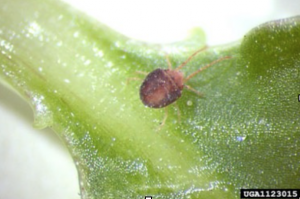
Figure 1. Clover mite. (Photo: Rayanne Lehman, Pennsylvania Department of Agriculture)
Clover Mites. Clover mites are occasional invaders that can become a problem in early spring. They are tiny (1/30-inch long), red to reddish- brown, oval-shaped mites. Clover mites, as do other arachnids, have 8 legs. They hold the front pair of legs straight out in front of the head. Many people actually mistake this pair of legs for antennae (Figure 1). Clover mites do not bite nor do they burrow under the skin. They are strictly plant feeders. Hosts include grasses, clover, and dandelion, to name a few.
Most heavy outbreaks occur in the early spring, especially around heavily fertilized lawns. The mites may invade homes and can leave a reddish-brown stain if crushed.
Control. An 18”-24” grass and weed-free zone around the structure’s perimeter can greatly reduce the number of invading clover mites (Figure 2). Treat a 5-10 foot wide area of ground along the foundation, as well as an 18-24 inch wide vertical band of the foundation wall with an appropriately labeled residual liquid insecticide.
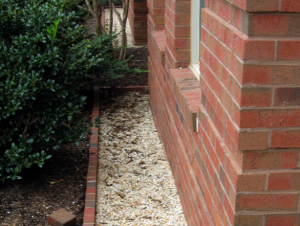
Figure 2. Placing gravel around the structure can help prevent clover mite invasions (Photo: M. Waldvogel, NCSU).
Many plants are actually unattractive to clover mites, including geranium, marigold, zinnia, salvia, rose, chrysanthemum petunia, juniper, spruce, yew and barberry. Planting these non-attractive plants in the weed-free zone will help reduce the number of clover mites around the structure. You may also recommend that your customers contact their county Cooperative Extension Center for advice on proper fertilization of their lawns.
The application of insecticides indoors for clover mites is not warranted. Your customer should simply use a vacuum cleaner to collect any mites found indoors. Care should be taken not to crush the mites. The vacuum bag should be sealed in a disposable plastic bag before throwing it away.
Carpenter Bees. Like other bees, carpenter bees are beneficial in that they pollinate crops and home gardens. However, homeowners are often frightened about being stung by the carpenter bees as they hover around their homes and other wooden structures while searching for mates and favorable sites to construct their nests. A male carpenter bee may be “aggressive” when protecting its nesting site, but is harmless because it does not have a stinger. And although a female has a stinger, she will not usually sting unless handled or bothered.
Carpenter bees nest in wood; common nesting sites include house siding, eaves, window trim, fascia boards, decks, fences, and outdoor furniture.
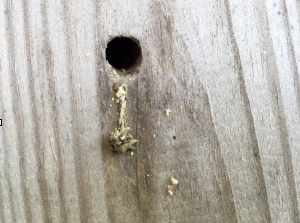
Figure 3. Carpenter bee entrance hole. (Photo: Patty Alder, NCSU)
One sign of carpenter bee infestation is the nearly perfect round 1⁄2-inch entrance holes in exposed exterior wooden surfaces (Figure 3). Another sign of activity is the pile of coarse sawdust underneath freshly drilled holes. The sawdust is cast out while carpenter bees excavate tunnels. Yet another sign of infestation is the yellow or brown staining from voided fecal matter.
Carpenter bees can cause considerable structural damage from repeated colonization of the same area. Woodpeckers often peck through the wood surface of carpenter bees’ tunnels to prey on the larvae inside, thus causing even more damage.
Prevention & Control. Bare, unpainted, or weathered softwood is especially vulnerable to carpenter bee attack. To help prevent carpenter bee infestation, paint or varnish all wood surfaces. For the best results, apply two coats of a good exterior primer and follow up with at least one coat of finish. Painting is not practical for many wood surfaces, however, and wood stains provide little protection.
In some cases, standard window screening can be used to keep bees from getting to areas of unpainted surfaces or other places where it might be difficult to paint. Strips of metal window screening work best; don’t use the fabric or plastic type. The screening can then be wedged or stapled into areas the bees are infesting.
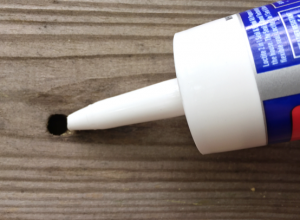
Figure 4. Carpenter bee holes may be sealed with caulk or wood putty. (Photo: Patty Alder, NCSU)
Spray or dust insecticide may be placed directly into the carpenter bees’ entrance holes or adjacent wood surface to reduce carpenter bee activity. These control efforts should be attempted in late afternoon or at night when the bees are inside the wood tunnels. Treated tunnels may be sealed with caulk or wood putty (Figure 4); however, do not plug the holes immediately. Bees should be able to pass freely through the nest entrance where they will contact the insecticide and distribute it inside the tunnels. Also, any new mature bees will emerge through the openings and contact the insecticide placed there. In the fall, the holes should be filled with caulk or wood putty.
Paper Wasps. Another insect you may begin receiving calls about (if you haven’t already!) is the paper wasp. We all know that these insects can become a problem in the fall as the inseminated queens invade homes in search of overwintering sites. But paper wasps can also become a problem in the spring. As spring approaches and temperatures begin to climb, queens that spent the winter in structures become active and fly about. If they have been resting in an attic, wall void or crawlspace, the wasps may be attracted to light coming through a gap in the baseboard or a wall fixture, or around an AC vent and emerge inside the building. Since there are no nests or young to defend, the only real danger of being stung is from accidentally stepping on or pressing against one.
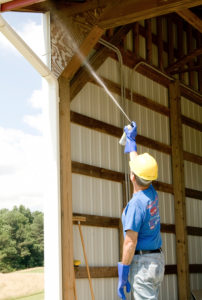
Figure 5. Use an aerosol insecticide to destroy a paper wasp nest (Photo: Patty Alder, NCSU).
Control. Queens that are found indoors may simply be swatted, or vacuumed. If a queen does manage to get outdoors and start a nest, a broom may be all that is needed to knock it down.
If a wasp nest has had some time to grow and is considered to be a hazard, they are most easily destroyed in the evening with an aerosol insecticide that is labeled for “hornets or wasps” (Figure 5).
Solitary Ground-Nesting Bees. There are several kinds of small hairy or metallic bees that dig into the soil to nest, often collectively referred to as digger bees. This is a diverse group that comes from different families and the term digger bee can include the andrenid bees, halictid bees, and colletid bees. These are solitary bees and native pollinators that are active early in the season.
Each female digs a cylindrical underground tunnel as a nest (as opposed to social bees such as honey bees where only the queen reproduces and maintains a colony with the help of sterile workers). The underground nest is provisioned with a mixture of nectar and pollen collected from nearby flowering plants. This serves as food for the bee’s offspring (larvae) that develop in the underground chamber and emerge as adults the following year.
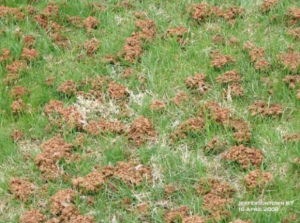
Figure 6. Digger bee mounds. (Photo from Ornamental Entomology ListServe)
Digger bees usually emerge in May and are active for a relatively short period – about 6-8 weeks or so. The first sign of digger bees in lawns is often little mounds of soil with a hole nearby (see Figure 6). The ground bees will also be flying over this area.
Control. Ground bees like dry soils. Watering the soil when bees first become active may deter nesting. Ground bees also prefer to nest in dry areas where the grass is thin. If possible, correct the problems making the turf thin. Find ways to thicken the turf in these areas to reduce ground bee problems. In areas that will not grow grass, mulching the area can help as well.
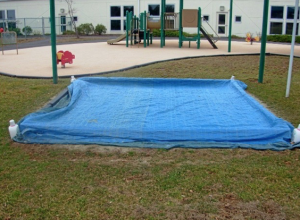
Figure 7. Sand boxes and other play areas may be covered with a tarp to reduce bee activity. (Photo: Mike Waldvogel, NCSU)
If the bees are flying around and attempting to nest in sandboxes or other areas children play, another option is to temporarily cover the area with a tarp until the bees have moved on (see Figure 7).
If you feel a pesticide is warranted, watch during the day to see where the holes are located. Each hole (nest) may then be treated directly with a dust or spray insecticide. A dust insecticide may cling to the bee’s body better than a spray. Keep people and pets out of the area while it is being treated.
Unwanted Fall Pests
Multi-colored Asian ladybird beetles.
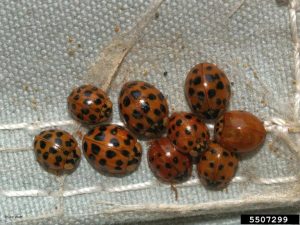
Figure 1. Multi-colored Asian ladybird beetles. (Photo: Bruce Watt, University of Maine, Bugwood.org).
Adult multi-colored Asian ladybird beetles are convex in shape and about 1/4” long. Specimens from higher elevations are larger than those from the Piedmont and Coastal Plains. There are usually ten black spots on each forewing, but some have fewer spots or faded spots and some have no spots at all (see Figure 1).
Adult beetles begin laying eggs on host plants in early spring. Eggs hatch in three to five days. Larvae are orange & black in color. Larvae molt four times, becoming larger after each molt, and enter an immobile pupal stage after the last molt. After several days, the adult beetle emerges from the pupal case.
Multicolored Asian lady beetles are effective predators of aphids and some scale insects and are extremely beneficial for both agricultural and horticultural crops.
As temperatures start to drop in the fall, adult beetles begin to search for suitable overwintering sites. They tend to congregate on the sunnier or warmer sides of buildings, or on exposed, light-colored buildings. Of course, this doesn’t mean that people with dark-colored siding, brick or log homes are immune to the lady beetle assault. On warm winter days, the beetles may become active and move towards light or bright surfaces. They are often found on windows, light fixtures and ceilings. Multi-colored Asian ladybird beetles do not reproduce indoors; in the spring, they will move outdoors in search of prey.
Ladybird beetles are primarily a nuisance. They do not eat wood or furniture. However, the beetles may stain fabric and painted surfaces if squashed. In addition, there have been concerns that large numbers of beetles may possibly cause air quality problems indoors that could trigger allergies and/or asthmatic reactions.
While it is not 100% effective, preventing the beetles from entering structures is one of the best long-term approaches for dealing with ladybird beetles. Recommend that clients install tight-fitting sweeps on exterior doors and weather stripping around door frames. Openings where utility pipes and wires enter the foundation and siding should be sealed. Make sure that window screens are in good condition. Indoor sprays tend to be ineffective against ladybird beetles. Invading beetles should simply be vacuumed up. The vacuum bag should be sealed up and disposed of. Outdoors, a residual spray insecticide may be applied around windows, doors, eaves, soffits, attic vents, etc.
Brown marmorated stink bug.
Its first detection in North Carolina was in Forsyth County in 2009, and it has since spread rapidly throughout the piedmont and mountain regions of the state. The coastal plain has had fewer occurrences during this period, although the insect has appeared in isolated locations. As of June 2016, it had been confirmed in 70 of NC’s 100 counties.
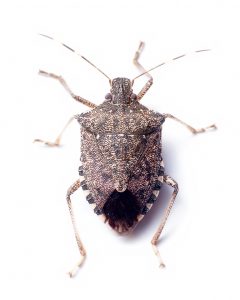
Figure 2. Adult brown marmorated stink bug. (Photo: Patty Alder, NCSU)
Adult brown marmorated stink bugs are slightly larger than 1/2” and vary in color from brown to gray. Adults have characteristic brown and white bands on the outer edge of the thorax, and white and brown banding on the next to last antennal segment (see Figure 2).
Adult females lay egg masses in midsummer. There are five nymphal stages. New adults emerge in late summer. In the fall, adult brown marmorated stink bugs aggregate on and inside houses, sheds and other structures in search of an overwintering sites. The bugs can give off a characteristic odor if they are crushed or disturbed.
Just as with ladybird beetles, exclusion goes a long way in preventing brown marmorated stink bug invasions. Make sure exterior doors have tight-fitting sweeps, seal openings where utility pipes and wires enter the foundation, and make sure window screens are in good condition.
The use of pesticides indoors for controlling the brown marmorated stink bug is not warranted; invading stink bugs should be removed with a vacuum cleaner. Outdoors, a residual spray applied around windows, doors, soffits, attic vents, and other potential entry points may provide some relief.
Paper wasps.
Adult paper wasps are about ¾” to 1” long and reddish brown to dark brown in color with yellow stripes on the abdomen. They are actually beneficial in that they feed on other insects.
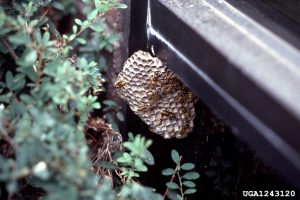
Figure 3. Paper wasps build single-comb umbrella-shaped nests (Photo: Whitney Cranshaw, CSU, Bugwood.org).
Paper wasps live in nests that usually contain around 250 individuals. Paper-like nests, shaped like tiny umbrellas (see Figure 3) are attached by a short stem to eaves, porch ceilings, attic rafters, decks, and other such protected places.
Paper wasp colonies are annual; workers die off in the fall and only inseminated queens survive. The surviving queens are often seen hovering around chimneys and rooflines as they search for a suitable place to spend the winter. On warm winter days, the queens may become active and may move into living areas of the home through openings such as heating vents, baseboards, and gaps around light fixtures.
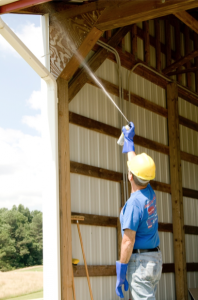
Figure 4. Paper wasp nests should be treated with a Wasp & Hornet spray that can propel the insecticide 10-15 feet (Photo: Patty Alder, NCSU).
Wasps that invade homes can be controlled mechanically, by swatting or vacuuming, or with an aerosol insecticide. Openings through which wasps can enter the structure should be caulked or sealed. In homes, attic vents should be properly vented to exclude overwintering queens. If an established nest is found in the attic, a total-release aerosol may be used on a warm day. Follow the product label instructions concerning how many cans are needed for the size area you are treating. Never exceed this number of units, and always be careful using these products near open flames.
If all the workers have not yet died, and a nest poses a hazard, use a Wasp & Hornet spray that will propel the insecticide about 10-15 feet and direct the spray into the nest opening for 5-10 seconds (see Figure 4).
Face flies and cluster flies.
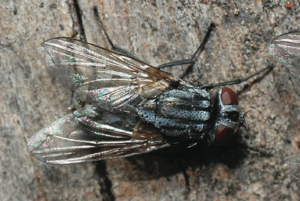
Figure 5. Adult face fly. (Photo: University of Nebraska-Lincoln Extension)
Adult face flies are about 3/8-inch long, slightly larger than the house fly. Females have a gray thorax with 4 dark stripes and the abdomen is mostly black with an orange base, while the male’s abdomen is orange-brown with a black base (see Figure 5)
Female face flies feed primarily on the tears, saliva, mucous, blood, and excrement of pasturing animals, especially cattle. They do not actually bite their victims. Male face flies spend their time perched on vegetation, awaiting mates. Face flies are most likely to invade farm homes or homes located near pastures or where cattle are kept.
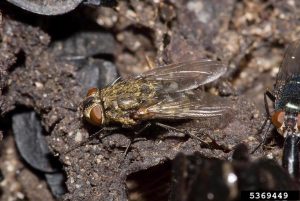
Figure 6. Adult cluster fly. (Photo: Susan Ellis, Bugwood.org)
Adult cluster flies are slightly larger than the house fly and dull gray in color with black markings. The thorax is covered with distinct golden-yellow hairs (see Figure 6).
Cluster flies have an interesting life history in that they are parasites of earthworms. Adults lay eggs on the soil and the hatching larvae enter earthworms, develop to their last larval stage, pupate and emerge as adults.
In the fall, adult cluster flies seek protected over-wintering sites within the cracks, crevices and voids of structures. Fortunately, they do not damage structures, but they may leave small dark-colored spots of excrement on windows and walls.
As with other overwintering pests, exclusion is one of the best approaches to preventing cluster fly and face fly invasions. Cracks around windows, doors, siding, utility pipes, behind chimneys, and underneath the fascia and other openings should be sealed. Damaged screens on doors and windows should be repaired or replaced. Light traps may be placed in voids or drop ceilings to help reduce fly numbers.
Indoor crack & crevice & void applications where flies are overwintering may be helpful. However, piles of dead flies left in the walls can sometimes lead to secondary infestations of carpet beetles. When using exterior sprays, it may be more effective to concentrate the chemical on the sunny side of the house, where the flies tend to aggregate.
Featured Insect: Field Ants (Formica spp.)
Formica ants, often referred to as field ants, are among the United States’ largest and most common ants. Distributed throughout NC, three species make the most common list: Formica pallidefulva and Formica incerta, both rust to red in color, and Formica subsericea, black in color with stripes of sparse golden hairs across their abdomens. Field ants have polymorphic (multiple-sized) workers ranging in size from ⅛ – ⅜ inches.
Field ants are commonly mistaken for carpenter (Camponotus) ants. Both are common, medium to large in size, with one node in between the thorax and abdomen. However, the two are quite easy to distinguish with a little practice.
If you look at a carpenter worker ant in side profile, you will notice that its thorax is evenly rounded and forms a single curve (see photo on left below). If you look at a field ant in side profile, you’ll notice that is thorax is not evenly rounded, but that it is broken into two distinct curves (see photo on right below).
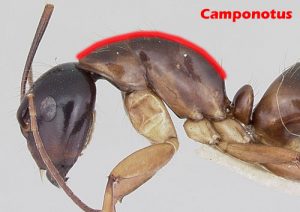
An evenly rounded thorax indicates Camponotus. (Image by Antweb.org)
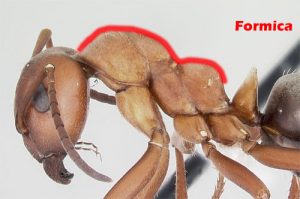
A thorax with two distinct curves indicates Formica. (Image by Antweb.org)
Field ants do not have a stinger, but instead they possess a circlet of hairs around an opening at the tip of their abdomen where formic acid is expelled as a defense mechanism. They may pinch skin with their mouthparts, and then squirt formic acid into the wound, which may feel like being stung.
They are found around structures, but do not often invade homes. They often nest in soil, but nests also may be found under lawn and wood debris such as stacks of firewood, bricks, stepping stones, potted plants, and other protected places. They may also be found nesting in foundation voids.
If control is necessary, try following workers back to their nest site. Once the nest is located, a mound drench with an appropriately labeled insecticide is an option. Or granular bait can be applied around the mound.
If ants are entering structures, a thorough perimeter treatment up and along the foundation wall an appropriate insecticide may be necessary. Treat around doorways and windows, and underneath siding.
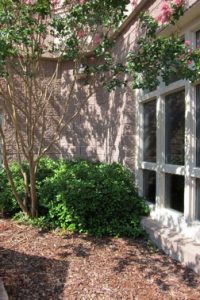
Vegetation touching structures should be trimmed back (Image by Patty Alder, NCSU)
In addition, make sure all potential entry points are sealed, especially where electrical and utility lines enter buildings. Any vegetation in contact with the foundation should be trimmed back, if possible (see image at right). Reduce or eliminate sources of moisture around the structure, and store firewood, piles of lumber, and other such items away from the foundation

